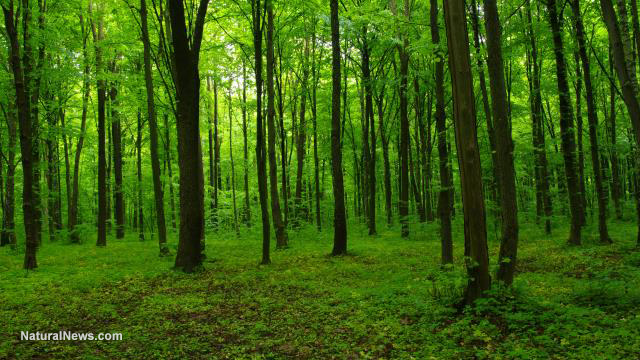Critical environmental collapse: Hundreds of millions of trees are dying in North America
Tuesday, November 29, 2016 by: J. D. Heyes
Tags: tree deaths, CO2 conversion, environmental collapse

(NaturalNews) In addition to the mass death of bees throughout the United States, there is another potentially life-ending death epidemic occurring as well: the death of millions of oxygen-producing trees.
As noted by the U.S. Department of Agriculture, U.S. Forest Service officials have documented and identified an additional 36 million dead trees across the state of California since their last aerial survey taken in May. The additional trees bring the total number of dead trees since 2010 to more than 102 million, on 7.7 million acres of the state's drought-stricken forest land.
This year alone, USDA and the Forest Service noted, 62 million trees have died, which is a 100 percent increase in dead trees across the state over the previous year. And what's more, millions of additional trees are in a weakened state and are expected to die out in the coming months and years.
Fast becoming non-renewable
The loss of this vital resource isn't just happening in California. It's also happening near Fukushima, Japan, site of the worst nuclear disaster since the mid-1980s; it's happening as fires rage through forest land in Indonesia; and it's happening throughout North America, the Waking Times reported.Recently, a study published in the journal Nature, estimated that the planet has 3.04 trillion trees. The research further noted that 15.3 billion trees are cut down annually, and that 46 percent of the world's trees have been cleared over the past 12,000 years.
So clearly, a renewable resource is fast becoming non-renewable.
"Trees are among the most prominent and critical organisms on Earth, yet we are only recently beginning to comprehend their global extent and distribution," said Thomas Crowther of the Netherlands Institute of Ecology, who conducted the research using satellite data and computer modeling.
The Waking Times noted further that the tree deaths in Northern California have been linked to Sudden Oak Death, in addition to the ongoing drought.
Elsewhere in the U.S., trees are becoming more scarce as well. For instance, in 2010, Hawaii's healthy ohi'a trees began to die off on the Big Island because of what is now referred to as ohi'a disease. Scientists still do not understand its origins, and as such do not yet know how to treat or prevent it.
Entire regions and mountainsides are losing trees, and in very short order. And while commercial logging operations include the replanting of harvested forests, trees take many years to mature. Also, some have speculated that the tree death is due to a confluence of issues – a sign that rugged trees, more hearty than any other plants, are in a generally weakened condition due to constant assault from pollution and even climate engineering projects.
Never too late to preserve what is left
As reported by the Christian-Science Monitor, today there are basically only two big forests left on the planet, according to research funded by the Natural Science Foundation. These are located in South America and Africa; the rest are isolated."'There are really only two big patches of intact forest left on Earth — the Amazon and the Congo — and they shine out like eyes from the center of the map,' lead author Nick Haddad, a professor at North Carolina State University, told the New Yorker."
The remaining forests are relatively fragmented, the researcher said. And nearly 20 percent of forested land lies about the length of a football field away from its edge, while almost 70 percent of forested land is within a half-mile of the forest's edge.
The fragmentation takes a major toll on wildlife and other living things. Researchers said that they found that fragmented habitats, on average, lose half their plant and animal species within 20 years.
Researchers noted that one way to reverse the fragmentation is to engage in a program to create corridors of trees, thereby connecting fragmented forestland.
"It's never too late to preserve what we already have," said Doug Levey, program officer with the National Science Foundation, and co-author of the paper.
Sources:
NaturalNews.com
FS.Fed.us
WakingTimes.com
CSMonitor.com
Tree deaths at FETCH.news
Get independent news alerts on natural cures, food lab tests, cannabis medicine, science, robotics, drones, privacy and more.
Take Action: Support Natural News by linking to this article from your website
Permalink to this article:
Embed article link: (copy HTML code below):
Reprinting this article:
Non-commercial use OK, cite NaturalNews.com with clickable link.
Follow Natural News on Facebook, Twitter, Google Plus, and Pinterest
- Red Cross issues warning to stop blood plasma donations from vaccinated people
- CNN runs bizarre headline proving the unvaccinated were right: The fully jabbed are “dying from Covid-19”
- The U.S. military, creator of the COVID VACCINE, already knew since 2016 that IVERMECTIN was the BEST product to use in the event of a pandemic
- PUSHED TOO FAR: Former Putin advisor says Russia has no choice but to use tactical NUCLEAR WEAPONS against NATO
- Amazon bans Dr. Paul Marik’s book on traditional, natural remedies for cancer
- Tyranny wins: Durov caves, deploys AI to “comb” Telegram users for illegal content
- Blatant democrat corruption: FCC fast-tracks approval for George Soros purchase of 200-plus U.S. radio stations in 40 markets weeks before presidential election
- RFK Jr. proposes subsidizing organic food, not Ozempic, as solution to obesity “for half the price”
- Why are Barack and Michelle Obama so closely tied to P. Diddy and many other elite rapists, sex offenders?
- Border Patrol warns that suspicious adults posing as “parents” are drugging, abducting young children to be trafficked into America
- Court dismisses wrongful death lawsuit against hospital where COVID-19 patient died after being switched from ivermectin to remdesivir
- Israel’s “exploding pagers” attack qualifies as a WAR CRIME under Geneva Conventions of 1949
- Sermon 3: Mike Adams explains the difference between MAN’S ECONOMY and GOD’S ECONOMY
- Convenient food storage solutions for easy relocation
- Garlic: Roto-rooter for the arteries?
- Failed Trump assassin Ryan Routh had list of every location where former president would be from August through October
- 23-year-old Florida woman develops blindness, autoimmune red blood cell wasting disease after doctors forced her to get three vaccine injections
- Microsoft to bring infamous nuclear plant back to life to feed POWER-HUNGRY AI data centers
- Red Cross issues warning to stop blood plasma donations from vaccinated people
- URGENT ALERT: UV laser directed energy attack alert – details on invisible, silent weaponry used to attack Trump and his supporters
- Former Big Tech exec warns of serious dangers linked to wireless technology
- FDA-approved monkeypox vaccine causes DEATH in the vaccinated and can spread to UNVACCINATED people and kill them too
- Mike Adams releases explosive new rap song, “God Is With Us”
- TROUBLE FOR KAMALA: Tim Walz now under investigation for ties to CCP
- PURE EVIL: Israel booby-trapped CHILDREN’S TOYS with explosives to kill Lebanese children
- CDC finally admits FLUORIDE is TOXIC to humans, especially babies, causing neurological damage, so why not remove it from all municipal tap water right away?
- Globalists throwing everything they have into trying to silence free speech worldwide (but it won’t work)
- INSANE COVID COURT convicts Austrian woman of "grossly negligent homicide" for "fatally infecting her neighbor with COVID-19"
- Hillary Clinton calls for criminal arrest of anyone who speaks against NATO, U.S. empire
- Entire board of 23andMe RESIGNS, leaving only Anne Wojcicki, deceased former YouTube CEO Susan Wojcicki’s sister at helm
- CNN runs bizarre headline proving the unvaccinated were right: The fully jabbed are “dying from Covid-19”
- Bill Gates launches new Netflix series that lays out mass suicide plan for global human depopulation
- Bulgaria - not Hungary - manufactured the pager bombs used in Israel attack against Hezbollah that left 37 dead, injured thousands
- Lebanon warns of “doomsday” response for West, Asia and Europe if Israel expands war
- RFK Jr. says DOJ under Trump will launch RICO investigations into collusion between medical boards, medical journals and Big Pharma
- Sunlight and clouds, not CO2, responsible for planetary climate changes
- Red Cross issues warning to stop blood plasma donations from vaccinated people
- Cancer researcher: IVERMECTIN can overcome chemotherapy resistance of TURBO CANCERS caused by mRNA vaccines
- Most of today's vaccines are developed with ABORTED FETAL CELL LINES – Here's the full list
- Christian churches that advocate for Israel’s mass killing of Palestinian civilians are serving SATAN, not Christ
- GLOBAL EMERGENCY UNFOLDING: Japan will unleash Bill Gates-approved, SELF-REPLICATING mRNA vaccines starting next month
- Haitian migrants demonstrate remarkable food survival skills – Americans, take note
- URGENT ALERT: UV laser directed energy attack alert – details on invisible, silent weaponry used to attack Trump and his supporters
- Dr. Sabine Hazan reveals that important gut bacteria are ERASED by COVID “vaccines”
- WEF admits COVID was a “test” of public obedience to new globalist world order
- More horrifying details emerge about the 20,000 Haitian migrants INVADING Springfield, Ohio: Residents are fleeing due to overwhelming VIOLENCE
- The migrant gang takeover of apartment buildings in Aurora, Colorado is just a small taste of the chaos to be unleashed against Americans
- UN and WHO coordinate massive POLIO vaccine experiment on 640,000 displaced Palestinian children
- The “public health” agenda of US regulators and pharmaceutical companies is actually a PUBLIC DEATH agenda
- DEAD HUMANS LIQUEFIED, then fed back to the population via fertilizer on crops
- U.S. Navy sailors CRIPPLED by COVID jabs - 17 support ships to be SIDELINED due to “post-COVID manpower issues”
- Ivermectin outperforms chemo in breast cancer treatment, study finds
- Dr. Malone explains how COVID-19 vaccines cause cancer in latest congressional hearing discussing vaccine injuries
- Bill Gates launches new Netflix series that lays out mass suicide plan for global human depopulation
- Red Cross issues warning to stop blood plasma donations from vaccinated people
- Heavily CENSORED Pfizer documents show that COVID began a five-year mass DEPOPULATION agenda that will reach completion by 2025
- 5G REMOTE KILL VECTOR: Science paper reveals cell phone signals can activate the release of biological PAYLOADS from graphene oxide injected into the body
- DATA: England’s vaccinated population had close to one million deaths in 23 months; unvaccinated population had less than 61,000 deaths over the same period
- New $4B Panasonic electric vehicle (EV) battery factory in Kansas requires so much power that the facility will need its own COAL plant to run
- Arizona residents drive entire Maricopa County Board of Supervisors out of meeting after serving them for TREASON
- Anonymous airline pilot exposes chemtrail operation in the U.K.
- Moderna admits mRNA COVID jab causes CANCER, billions of DNA fragments found in vials
- People who got COVID jabbed now displaying major personality changes stemming from vaccine-induced neurological damage, experts warn
- SOURCES: Jamie Foxx was forced against his will to get covid jabbed for movie, then developed debilitating blood clot in his brain
- Scientists confirm: GENIUS brain function can be spontaneously unleashed in humans without any apparent cause
- Today I asked our AI language model “Neo” about which phytonutrients or phytochemicals can block the spike protein related to SARS-CoV-2 … Here is what it answered…
- Study: TikTok trend of hotwiring certain car models linked to surge in car thefts in U.S. cities
- Fully vaccinated about to see “tsunami” of illness and death, warns virologist
- Full-scale medical martial law coming to America in 2024
- Natural News issues statement on Hamas terror attack on Israel, bombings of Gaza, ethnic cleansing vs humanitarian principles
- Former Bill Gates vaccine scientist predicts sharp population decline: “up to 30-40% in highly vaccinated countries”
- BREAKING: 2025 NDAA authorizes mandatory military draft of WOMEN across America… as Pentagon pursues global NUCLEAR war with both Russia and China at the same time
Science News & Studies
Medicine News and Information
Food News & Studies
Health News & Studies
Herbs News & Information
Pollution News & Studies
Cancer News & Studies
Climate News & Studies
Survival News & Information
Gear News & Information
News covering technology, stocks, hackers, and more



"Big Tech and mainstream media are constantly trying to silence the independent voices that dare to bring you the truth about toxic food ingredients, dangerous medications and the failed, fraudulent science of the profit-driven medical establishment.
Email is one of the best ways to make sure you stay informed, without the censorship of the tech giants (Google, Apple, Facebook, Twitter, YouTube, etc.). Stay informed and you'll even likely learn information that may help save your own life."
–The Health Ranger, Mike Adams























